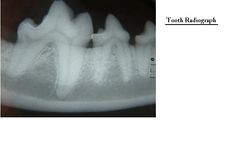Difference between revisions of "Tooth Eruption"
| (One intermediate revision by the same user not shown) | |||
| Line 1: | Line 1: | ||
| − | + | ==Deciduous Tooth== | |
| − | Eruption occurs after the [[ | + | Eruption occurs after the [[Tooth - Anatomy & Physiology#Crown|crown]] has fully formed (prior to complete [[Tooth - Anatomy & Physiology#Root|root]] formation). It provides the space required for [[Tooth - Anatomy & Physiology#Root|root]] completion. The epithelial covering is continuous with gums after eruption. Erosion (wear) removes the epithelium. The 'toothless' gene stops eruption. |
[[Image:Tooth Radiograph.jpg|thumb|right|250px|Tooth Radiograph - Copyright Nottingham 2008]] | [[Image:Tooth Radiograph.jpg|thumb|right|250px|Tooth Radiograph - Copyright Nottingham 2008]] | ||
| − | + | ==Permanent Tooth== | |
The tooth migrates into the socket of the deciduous tooth on the lingual side. It increases the pressure on the deciduous tooth by increased growth. Resorption of the deciduous tooth root leads to its loosening. The deciduous tooth then sheds and the permanent tooth replaces it. Premature loss of the deciduous tooth leads to disorganised (non-occluding) permanent teeth. | The tooth migrates into the socket of the deciduous tooth on the lingual side. It increases the pressure on the deciduous tooth by increased growth. Resorption of the deciduous tooth root leads to its loosening. The deciduous tooth then sheds and the permanent tooth replaces it. Premature loss of the deciduous tooth leads to disorganised (non-occluding) permanent teeth. | ||
| + | |||
| + | ==Timing of Tooth Eruption in the Dog== | ||
| + | |||
| + | The incisors normally start to change at three months of age, the permanent canine teeth are normally present by 6 months of age and fully erupted by 9 months of age. | ||
{{Unfinished}} | {{Unfinished}} | ||
[[Category:Teeth - Anatomy & Physiology]] | [[Category:Teeth - Anatomy & Physiology]] | ||
Latest revision as of 17:38, 13 January 2015
Deciduous Tooth
Eruption occurs after the crown has fully formed (prior to complete root formation). It provides the space required for root completion. The epithelial covering is continuous with gums after eruption. Erosion (wear) removes the epithelium. The 'toothless' gene stops eruption.
Permanent Tooth
The tooth migrates into the socket of the deciduous tooth on the lingual side. It increases the pressure on the deciduous tooth by increased growth. Resorption of the deciduous tooth root leads to its loosening. The deciduous tooth then sheds and the permanent tooth replaces it. Premature loss of the deciduous tooth leads to disorganised (non-occluding) permanent teeth.
Timing of Tooth Eruption in the Dog
The incisors normally start to change at three months of age, the permanent canine teeth are normally present by 6 months of age and fully erupted by 9 months of age.
| This article is still under construction. |
